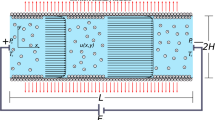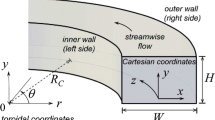Abstract
In order to examine the effects of the fluid type as the electrolyte solvent on the efficiency of electrokinetic energy conversion, a comparative numerical study among three different fluid types of a transient electrokinetic flow through a single circular finite length microchannel has been conducted. The system was initially at an equilibrium non-flow state, and a step change in flow was applied and the calculation proceeding until steady state was achieved. The analysis was based on non-dimensional transport governing equations that were scaled using Debye length as the characteristic length scale and diffusion time as characteristic time scale. The fluid types considered were shear thinning, Newtonian, and shear thickening, and a power law modeled them with the scaled flow behavior index having values of 0.2, 1.0, and 1.8. In order to isolate the electrokinetic effects of the different relationships between the shear strain rate and shear stress, the flow consistency index was adjusted so that in all the cases the flow rate and total pressure drop matched that of water at 25 °C. All other fluid and interfacial properties were the same for all cases. The key observational difference between the various fluid types was that their different axial velocity profile acted on essential the same free charge density profiles. Consequently, the convection current density (i.e., the radial distribution of charge being advected along the channel) was strongly affected by the fluid type. Integration of this quantity to calculate the convection current showed that for the particular fluid properties chosen the shear thinning fluid was 20 % higher than the Newtonian fluid, while the shear thickening fluid was only 4 % lower than the Newtonian fluid. Combined with the effects, these different currents have on the streaming potential, the shear thinning fluid was 50 % more effective in converting flow work to electrical work than the Newtonian fluid, while the shear thickening fluid was only 16 % lower than the Newtonian fluid.












Similar content being viewed by others
References
áde Vreede LJ, den Berg A, Jan CT (2013) Highly enhanced energy conversion from the streaming current by polymer addition. Lab Chip 13(16):3210–3216
Afonso AM, Alves MA, Pinho FT (2009) Analytical solution of mixed electro-osmotic/pressure driven flows of viscoelastic fluids in microchannels. J Nonnewton Fluid Mech 159(1):50–63
Babaie A, Sadeghi A, Saidi MH (2011) Combined electroosmotically and pressure driven flow of power-law fluids in a slit microchannel. J Nonnewton Fluid Mech 166(14):792–798
Bandopadhyay A, Chakraborty S (2015) Consistent prediction of streaming potential in non-Newtonian fluids: the effect of solvent rheology and confinement on ionic conductivity. Phys Chem Chem Phys 17(11):7282–7290
Bautista O, Sánchez S, Arcos JC, Méndez F (2013) Lubrication theory for electro-osmotic flow in a slit microchannel with the Phan-Thien and Tanner model. J Fluid Mech 722:496–532
Berli CL (2010a) Output pressure and efficiency of electrokinetic pumping of non-Newtonian fluids. Microfluid Nanofluidics 8(2):197–207
Berli CL (2010b) Electrokinetic energy conversion in microchannels using polymer solutions. J Colloid Interface Sci 349(1):446–448
Berli CL, Olivares ML (2008) Electrokinetic flow of non-Newtonian fluids in microchannels. J Colloid Interface Sci 320(2):582–589
Bharti RP, Harvie DJ, Davidson MR (2009) Electroviscous effects in steady fully developed flow of a power-law liquid through a cylindrical microchannel. Int J Heat Fluid Flow 30(4):804–811
Bird RB, Armstrong RC, Hassager O (1987) Dynamics of polymeric liquids, vol 1: fluid mechanics, 2nd edn. Wiley-Interscience, New York
Daiguji H, Yang P, Majumdar A (2004) Ion transport in nanofluidic channels. Nano Lett 4(1):137–142
Das S, Chakraborty S (2006) Analytical solutions for velocity, temperature and concentration distribution in electroosmotic microchannel flows of a non-Newtonian bio-fluid. Anal Chim Acta 559(1):15–24
Dutta D, Ramachandran A, Leighton DT Jr (2006) Effect of channel geometry on solute dispersion in pressure-driven microfluidic systems. Microfluid Nanofluidics 2(4):275–290
Gillespie D (2012) High energy conversion efficiency in nanofluidic channels. Nano Lett 12(3):1410–1416
Khair AS, Posluszny DE, Walker LM (2012) Coupling electrokinetics and rheology: electrophoresis in non-Newtonian fluids. Phys Rev E 85(1):016320
Kilsgaard BS, Haldrup S, Catalano J, Bentien A (2014) High figure of merit for electrokinetic energy conversion in Nafion membranes. J Power Sources 247:235–242
Mansouri A, Kostiuk LW (2016) Giant streaming currents measured in a gold sputtered glass microchannel array. Chem Phys Lett 646:81–86
Mansouri A, Scheuerman C, Bhattacharjee S, Kwok DY, Kostiuk LW (2005a) Transient streaming potential in a finite length microchannel. J Colloid Interface Sci 292:567–580
Mansouri A, Scheuerman C, Bhattacharjee S, Kwok DY, Kostiuk LW (2005b) Influence of entrance and exit conditions on the transient evolution of streaming potential in a finite length microchannel. In: ASME 3rd international conference on microchannels and minichannels, pp 541–549
Mansouri A, Kostiuk LW, Bhattacharjee S (2007) Transient electrokinetic transport in a finite length microchannel: currents, capacitance, and an electrical analogy. J Phys Chem B 111:12834–12843
Mansouri A, Kostiuk LW, Bhattacharjee S (2008) Streaming current measurements in a glass microchannel array. J Phys Chem C 112(42):16192–16195
Mansouri A, Bhattacharjee S, Kostiuk L (2012) High-power electrokinetic energy conversion in a glass microchannel array. Lab Chip 12(20):4033–4036
Mansouri A, Bhattacharjee S, Kostiuk LW (2014) Electrokinetic energy conversion by microchannel array: electrical analogy, experiments, and electrode polarization. J Phys Chem C 118(42):24310–24324
Masliyah JH, Bhattacharjee S (2006) Electrokinetic and colloid transport phenomena. Wiley, New York
Morrison FA, Osterle JF (1965) Electrokinetic energy conversion in ultrafine capillaries. J Chem Phys 43:2111–2115
Raza SH, Marsden SS (1967) The streaming potential and the rheology of foam. Soc Petrol Eng J 7(04):359–368
Ren L, Li D, Qu W (2001) Electro-viscous effects on liquid flow in microchannels. J Colloid Interface Sci 233(1):12–22
Sánchez S, Arcos J, Bautista O, Méndez F (2013) Joule heating effect on a purely electroosmotic flow of non-Newtonian fluids in a slit microchannel. J Nonnewton Fluid Mech 192:1–9
Tang GH, Li XF, He YL, Tao WQ (2009) Electroosmotic flow of non-Newtonian fluid in microchannels. J Nonnewton Fluid Mech 157(1):133–137
Van der Heyden FHJ, Stein D, Dekker C (2005) Streaming currents in a single nanofluidic channel. Phys Rev Lett 95(11):116104
Van der Heyden FH, Bonthuis DJ, Stein D, Meyer C, Dekker C (2007) Power generation by pressure-driven transport of ions in nanofluidic channels. Nano Lett 7(4):1022–1025
Vasu N, De S (2010) Electroosmotic flow of power-law fluids at high zeta potentials. Colloids Surf, A 368(1):44–52
Yang J, Lu F, Kostiuk LW, Kwok DY (2003) Electrokinetic microchannel battery by means of electrokinetic and microfluidic phenomena. J Micromech Microeng 13(6):963
Yang J, Masliyah JH, Kwok DY (2004) Streaming potential and electroosmotic flow in heterogeneous circular microchannels with nonuniform zeta potentials: requirements of flow rate and current continuities. Langmuir 20(10):3863–3871
Zhao C, Yang C (2011) An exact solution for electroosmosis of non-Newtonian fluids in microchannels. J Nonnewton Fluid Mech 166(17):1076–1079
Zhao C, Yang C (2013) Electrokinetics of non-Newtonian fluids: a review. Adv Colloid Interface Sci 201:94–108
Acknowledgements
Financial support for this work was provided by the Natural Science and Engineering Research of Canada.
Author information
Authors and Affiliations
Corresponding author
Rights and permissions
About this article
Cite this article
Mansouri, A., Vali, A. & Kostiuk, L.W. Electrokinetic power generation of non-Newtonian fluids in a finite length microchannel. Microfluid Nanofluid 20, 71 (2016). https://doi.org/10.1007/s10404-016-1735-0
Received:
Accepted:
Published:
DOI: https://doi.org/10.1007/s10404-016-1735-0




